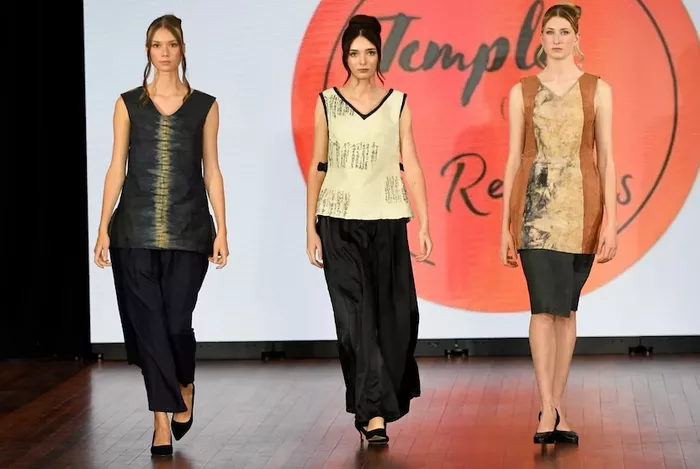Each year, the average Australian discards around 11 kilograms of clothing, according to the latest National Waste Report. In light of this environmental concern, some designers are turning to unconventional materials—such as paper—to offer an eco-friendly alternative to fast fashion. Australian designer Anzara Clark is at the forefront of this movement, drawing attention to paper fashion as a sustainable and surprisingly durable solution.
Though paper might be perceived in the West as a fragile and disposable material, Clark is challenging these assumptions through her work. She frequently holds sold-out workshops to dispel myths about paper’s limitations and showcase its strength. “I’ve got a paper vest that I made as a prototype last year, and I’ve worn it 60 times—it’s still in fantastic condition,” she said. Highlighting the material’s deep historical roots, she added that in Japan, armor was once made from paper using specialized techniques.
Transforming paper into wearable clothing is a labor-intensive process that requires time, strength, and skill. Clark uses Japanese washi paper, made from mulberry bark, which she processes and dyes by hand. Each sheet can take four to six days to prepare, involving massaging oils and dyes into the fibers—a task she admits takes a toll on her shoulders and neck. Despite the physical demands, her work has garnered attention at events like Eco Fashion Week in Western Australia and Craft Lab in Ballarat, Victoria. Currently, she is fundraising in hopes of accepting an invitation to present at the prestigious London Fashion Week.
Clark’s journey into paper fashion began during her recovery from surgery when she experimented with weaving old Japanese account book pages. What started as a simple pastime evolved into a serious artistic practice. She later studied traditional paper-making techniques in Korea and Japan, which helped her develop her own line of paper-based garments and accessories.
Melbourne-based designer and RMIT academic Jake Nakashima-Edwards is another advocate of paper fashion. His research traces the use of paper garments back to 9th-century Japan, where Buddhist monks repurposed paper used in calligraphy for clothing. By the Edo period, paper had become a staple material in everyday Japanese life, used for clothing, farming gear, and even furniture. According to Nakashima-Edwards, traditional paper clothing—unlike the flimsy paper used today—was strengthened with oils and starches, making it highly durable and even water-resistant.
This tradition of using mulberry-based cloth extends beyond Japan to the wider Asia-Pacific region, including the tapa textiles of the Pacific Islands. In the West, paper garments occasionally gained popularity during periods of material scarcity, such as in post-war Germany. The 1960s also saw a brief trend in disposable paper clothing among celebrities like Andy Warhol. However, with the rise of industrialized textile manufacturing, paper fashion fell out of favor and today survives in only a few niche circles around the globe.
Despite its historical depth and growing curiosity, paper fashion is unlikely to become a mass-market solution. Both Clark and Nakashima-Edwards acknowledge that due to its labor-intensive production and high cost, paper clothing is not a magic fix for the environmental issues plaguing the fashion industry. Nevertheless, they believe it offers meaningful contributions to the sustainable fashion conversation. Nakashima-Edwards emphasized the material’s ability to encourage a more mindful approach to clothing consumption: “It also helps to make you reassess—should I be buying all these clothes and just throwing them away? Or should I be repairing them and treating them with the care they deserve?”
Studio assistant Rose Kudlicki experienced the practicality of paper clothing firsthand while modeling Clark’s designs for Eco Fashion Week. Initially concerned about the garment tearing, she was pleasantly surprised by its strength and comfort. “It was so comfortable and just unexpectedly very wearable,” she said. So inspired by the experience, Kudlicki is now interning with Clark and shares her passion for traditional craftsmanship. “I really like that Anzara works with tradition and resourcefulness—it’s something you don’t see so much of at the moment.”
While paper clothing may not be the mainstream answer to the problems of fast fashion, designers like Clark and Nakashima-Edwards are showing that innovation grounded in tradition can inspire new ways of thinking about sustainability and garment production. Their work serves as a reminder that fashion can be both an art form and a vehicle for environmental change.
Related Topics
- Ethnic Elegance Shines at Third International Fashion Week Ak Buura 2025 in Osh
- Jeremy Strong’s Bold Cannes Fashion is Shaking Up Red Carpet Menswear Norms
- Kendall Jenner and Hailey Bieber Shine in Kylie Jenner’s Dazzling KHY x Dilara Fındıkoğlu Collection Debut

